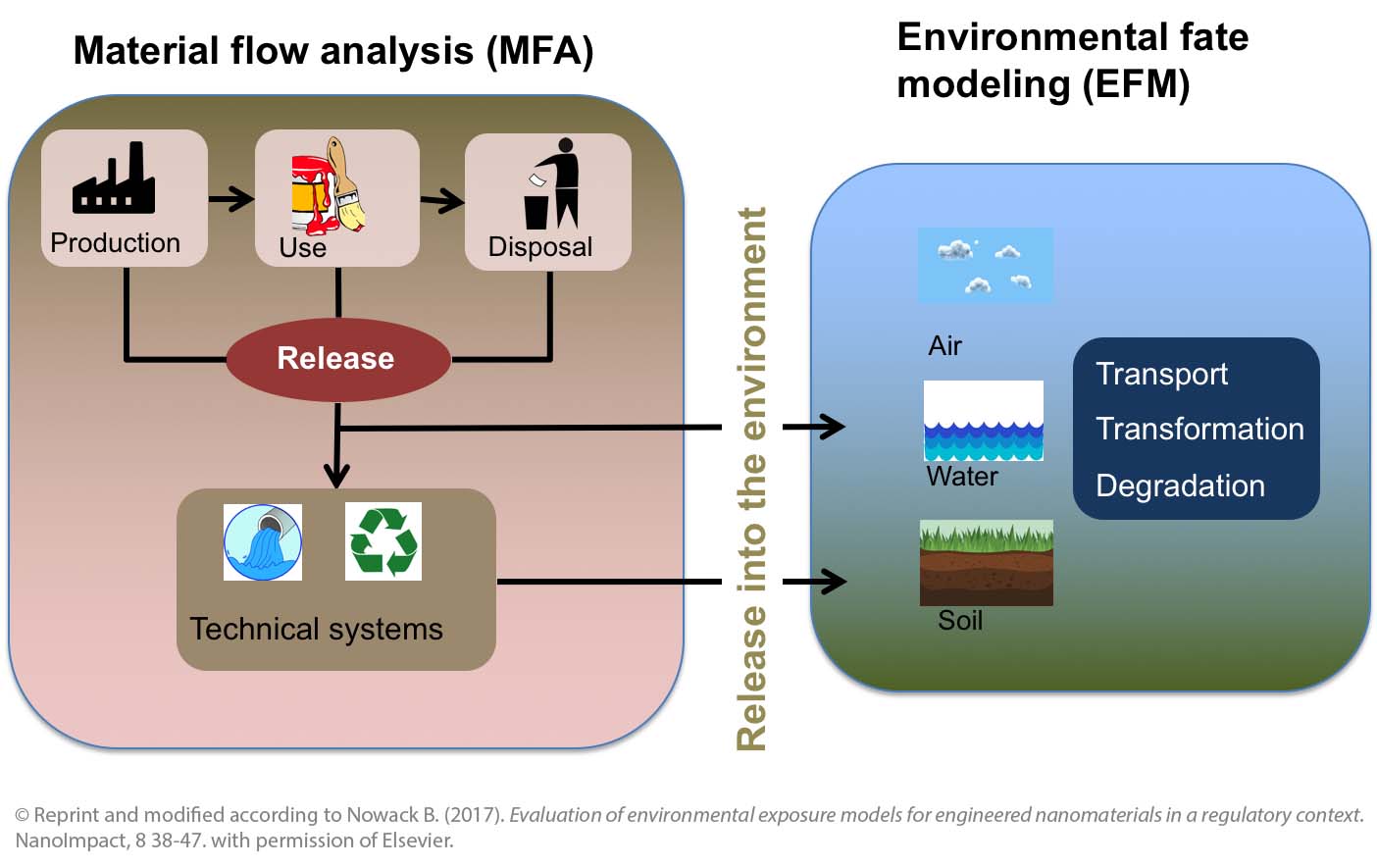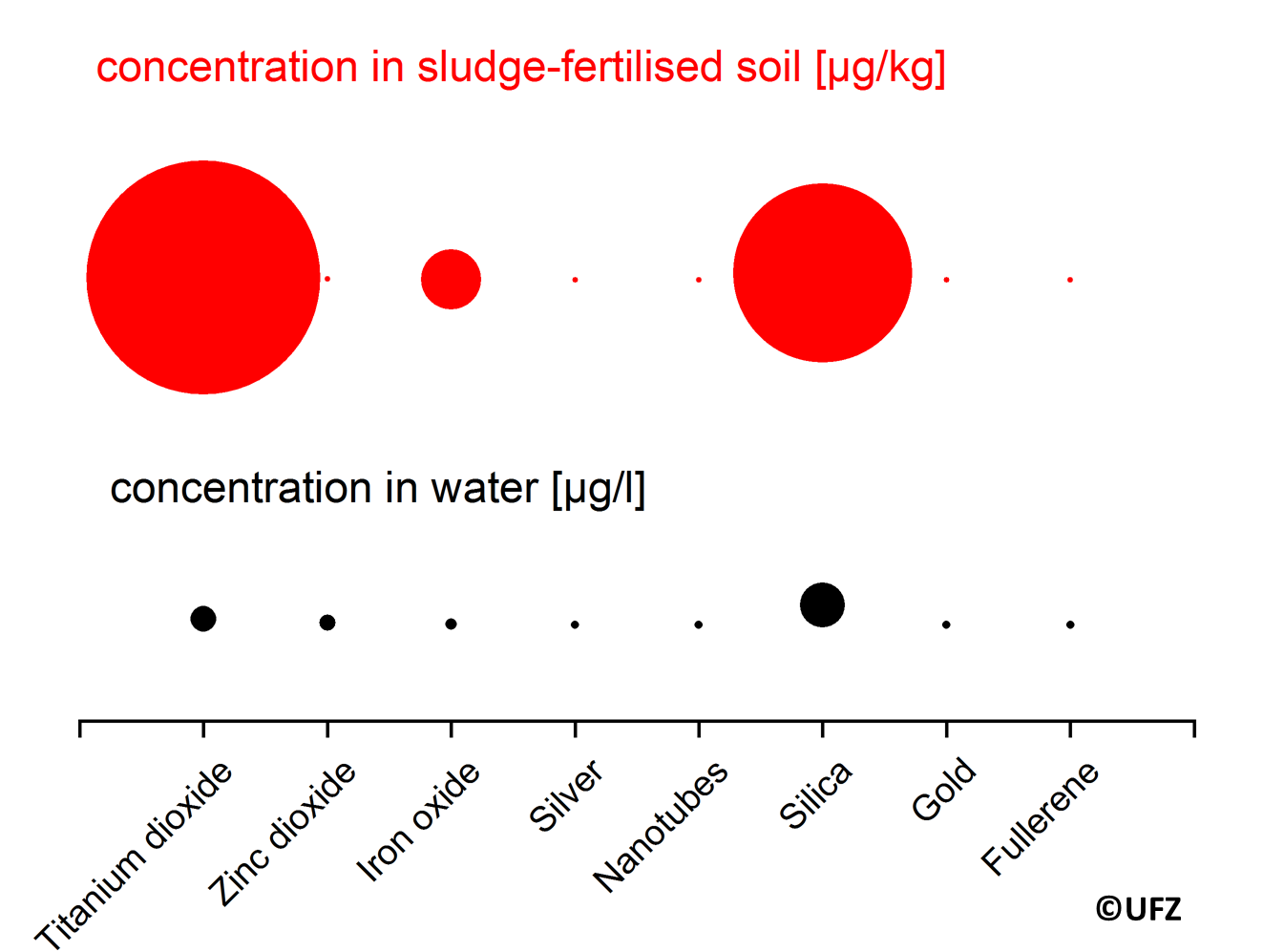To perform a risk assessment of nanomaterials in the environment, information on the exposure, i.e. the amounts that are present in the environment, is essential. In contrast to many other known pollutants, the concentrations of nanomaterials in environmental systems cannot be measured directly. In this situation, exposure modelling is a solution to estimate the environmental exposure with synthetic nanomaterials.
Why modelling?
Using current analytical methods, it is hard and laborious to detect synthetic nanomaterials directly in the environment (see cross cutting topic – detecting nanomaterials in the environment). Therefore, there is (still) no evidence from measurements as to how many synthetic nanomaterials can already be found in the environment today. Exposure modelling is a good and robust alternative. Based on different assumptions, the amount of nanomaterials in different areas of the environment is calculated. Exposure modelling has already been successfully applied to many other pollutants. Thanks to the progress made over the last 10 years, adapted exposure models now allow quite accurate predictions of the quantities of nanomaterials in the environment [1-3, 6].
The exposure models

Exposure models Material flow analysis (left) and environmental behaviour modelling (right). The material flow analysis calculates the release of nanomaterials into the environment, environmental behaviour modelling describes the distribution in the environment. © Reprint and modified according to Nowack B. (2017). Evaluation of environmental exposure models for engineered nanomaterials in a regulatory context. NanoImpact, 8 38-47. with permission of Elsevier.
In order to predict the amount of a nanomaterial in a certain environmental compartment (environmental exposure) present in a certain area, two basic types of models are required.
With the help of material flow analysis, the first step is to determine how many nanomaterials are released into the environment from production, use and disposal. In a second step, environmental fate models are used to predict the further behavior and distribution of nanomaterials within different environmental compartments such as water, air and soil.
The Material Flow Analysis
Material flow analysis is based on an analysis of the complete life cycle of all products which contain a specific nanomaterial. The life cycle starts with the production of the nanomaterial and the subsequent manufacturing of the nanoproduct. The product is used for a certain time and is either used up during this time (e.g. sunscreen) or disposed after use. In each life cycle stage nanoparticles can be released.
The release into the environment occurs either directly, e.g. via sunscreen use at the beach, or indirectly after wastewater or waste treatment (see cross-cutting topics – nanomaterials in waste & nanomaterials in the wastewater treatment plant). The material flow analysis quantifies all material flows for the nanomaterials and the corresponding nanoproducts. This allows simplified calculations of the environmental concentrations in a specific area (e.g. soil). These nanomaterial flows into the environment constitute also a basic input for environmental fate models.
The Environmental Fate Modelling
With environmental fate modelling the transport, transformation and degradation of nanomaterials in the environment can be predicted (see basics section). These calculations not only consider the properties of the nanomaterials but also the interactions with water and soils, e.g. Solubility or Agglomeration. With the help of these fate models it can then be predicted if a nanomaterial is transported over long distances or if it is deposited rapidly, e.g. in sediments.
Modelled Concentrations

Predicted environmental concentrations of nanomaterials in surface waters and sludge-treated soils. Mostly, higher concentrations of nanomaterials are predicted in sludge-treated soils. This is due to the removal of nanomaterials in sewage treatment plant and the subsequent deposition in the sewage sludge. © UFZ.
The most important information for the calculation of the environmental concentrations is the production quantity of a nanomaterial, the life cycle of the most important nanoproducts, the amount of nanomaterials removed via waste water treatment and waste disposal, and the fraction recovered during recycling.
Generally, nanomaterials produced in larger quantities have higher environmental concentrations than those who have only limited applications. However, the life-cycle of the nanoproducts has a large influence on the actual release. A large release occurs for example from cosmetics. Because of the efficient removal of nanomaterials during wastewater treatment, large amounts are transferred into sewage sludge. When sludge is used as fertiliser on agricultural fields, high concentrations of nanomaterials in these soils can be expected. Generally, the calculations show that a large part of the nanomaterials either ends up in waste and is subsequently incinerated or landfilled or is contained in products that enter material recovery or recycling.
The figure shows the predicted environmental concentrations (PEC) for some nanomaterials in surface waters and sewage-sludge treated soils. Most of the nanoparticles occur in water only in a concentration of less than one millionth gram per liter, some like nanosilver even only at a level of a billionth gram per liter.
Similar calculations have been performed for other environmental compartments such as sediments and soils, but also concentrations in landfills and sewage sludge have been calculated. In sewage-sludge treated soils the concentrations of some nanomaterials like titanium dioxide are quite high and can reach even several milligrams per kilogram soil [2-7].
In general the amounts of nanomaterials in the environment can be predicted quite well using the method of exposure modelling. The modelled concentrations replace the measured environmental concentrations which cannot be obtained at the moment due to missing analytical methods. Modelled environmental concentrations are important in order to be able to make conclusions about possible effects in the environment and thus constitute one basis for environmental risk assessments.
Literature
- Nowack, B. (2017), NanoImpact, 8: 38-47.
- Sun, T. Y. et al. (2016), Environ. Sci. Technol. 50: 4701-4711.
- Wang, Y. et al. (2016), Sci. Total Environ. 545-546: 67-76.
- Wang, Y. et al. (2016), Nanotoxicology 10: 1545-1554.
- Mahapatra, I. et al. (2015), J. Nanobiotechnol. 13: 93.
- Sun, T. Y. et al. (2014), Environ. Pollut. 185: 69-76.
- Wigger, H. et al. (2018), Environ Sci-Nano, 5(6): 1372-1385.
 >
>